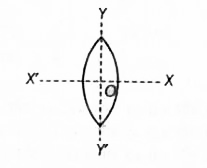An equiconvex lens is cut into two halves along (i) XOX' and (ii) YOY' as shown in the figure. Let f, f ', f " be the focal lengths of the complete lens, of each half in case (i), and of each half in case (ii), respectively.

Choose the correct statement form the following.Solution in Marathi
f'=2f, f'=f
f'=f, f''=f
f'=2f, f''=2f
f'=f, f'=2f
The correct Answer is:D
Step by step video & image solution for An equiconvex lens is cut into two halves along (i) XOX' and (ii) YOY' as shown in the figure. Let f, f ', f " be the focal lengths of the complete lens, of each half in case (i), and of each half in case (ii), respectively. Choose the correct statement form the following. by Physics experts to help you in doubts & scoring excellent marks in Class 11 exams.
Updated on:21/07/2023Topper's Solved these Questions
- RAY OPTICSBOOK - TARGET PUBLICATIONCHAPTER - RAY OPTICSEXERCISE - EVALUATION TEST
16 Videos
- RAY OPTICSBOOK - TARGET PUBLICATIONCHAPTER - RAY OPTICSEXERCISE - CRITICALTHINKING
38 Videos
- OPTICSBOOK - TARGET PUBLICATIONCHAPTER - OPTICSEXERCISE - EXERCISE
447 Videos
- REFRACTION OF LIGHT BOOK - TARGET PUBLICATIONCHAPTER - REFRACTION OF LIGHT EXERCISE - EVALUATION TEST
15 Videos
Similar Questions
When image is fomred by reflaction, the field of veiw is maximum for
View SolutionA concave mirror is placed on a horizontal table, with its axis directed vertically upwards. Let O be the pole of the mirror and C its centre of curvature. A point object is placed at C. It has a real image, also located at C. If the mirror is now filled with water, the image will be.
View SolutionLight is a form of energy which travels as ________.
View SolutionAssertion : The images formed by total internal reflections are much brighter than those formed by mirrorrs or lenses.
Reason : There is no loss of intensity in total internal reflection.
View SolutionAn equiconvex lens is cut into two halves along (i) XOX^(') and (ii) YOY^(') as shown in the figure. Let f,f^(')f^('') be the focal lengths of the complete lens, of each half in case (i) , and of each half in case (ii) , respectively Choose the correct statement from the following
View SolutionAn equiconvex lens of focal length 15 cm is cut into two equal halves in thickness. What is the focal length of each half ?
View SolutionThe figure shows and equiconvex lens of focal length f. It the lens is cut along PQ, the focal length of each half will be

View SolutionThe equiconvex lens has focal length f. If is cut perpendicular to the principal axis passin through optical centre, then focal length of each half is
View SolutionFocal length of convex lens is f. If this lens is cut along parallel to its length in two equal parts then focal length of its half part will be:
View Solutionएक द्विउत्तल लेंस को दो भागों मं काटा गया है
(i) XOX’ के अनुदिश
(ii) YOY’ के अनुदिश यदि f,f’,f’’ तीनों स्थितियों में लेंस की फोकस दूरियां हैं तो निम्न में से कौन सा संबंध सही है?

View Solutionएक समोत्तल लेन्स , चित्र VI. 20 में दिखाए अनुसार (i) X' OX और (ii) YOY' के अनुदिश दो अर्धभागों में काटा जाता है। मान लें कि पूर्ण लेन्स , परिस्थिति (i) में हर आधे भाग और परिस्थिति (ii) में हर आधे भाग की फ़ोकस दूरियाँ , क्रमशः f , f' और f'' हैं। निम्न में से सही कथन चुनें

View SolutionA convex lens has a focal length f. It is cut inti two parts along the dotted lines as shown ii figure. The focal length of each part will be …....... .

View SolutionA biconvex lens is cut in such a way that its equal two halves are (i) XOX. and (ii) YOY.axis respectively. If the focal length of original lens is fi f. is focal length in case (i) and fi in case (ii), then which of the following is true ?
View SolutionThe equiconvex lens has focal length f. If is cut perpendicular to the principal axis passing through optical centre, then focal length of each half is
View SolutionAn equiconvex lens is cut into two halves along (i) XOX' and (ii) YOY' as shown in the figure. Let f, f ', f " be the focal lengths of the complete lens, of each half in case (i), and of each half in case (ii), respectively.

Choose the correct statement form the following.
View SolutionThe figure shows and equiconvex lens of focal length f. It the lens is cut along PQ, the focal length of each half will be

View Solution
